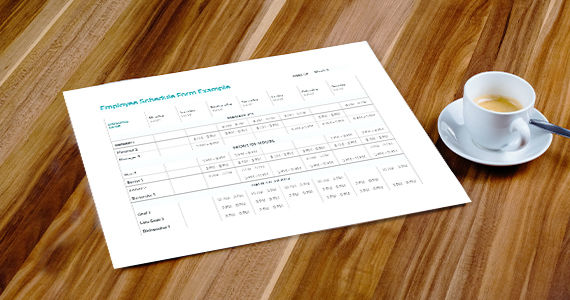As a restaurant manager, you’ve got a lot on your plate. Considering that 51% of restaurateurs cite staffing issues as their biggest challenge, it’s worth your time to address headaches like scheduling, so you can focus on making sure your guests are happy. One way to do this is by implementing a rotating schedule.
Popular in many businesses open outside of regular work hours, a rotating schedule not only helps you keep your restaurant fully staffed, but it can also keep employees happy and productive.
In this guide to rotating work schedules, we’ll break down:
- The answer to the question, “What is a rotating schedule?”
- 4 types of rotating schedules
- The benefits of rotational work schedules
- How to create a rotating schedule
Let’s dive in!

Schedule restaurant employees faster with our free, fillable form.
What is a Rotating Schedule and How Does it Work in a Restaurant?
Before you can learn how to master staff scheduling at your restaurant, you need to understand the ins and outs of rotation shifts.
The concept of a rotating work schedule is simple. It’s a type of schedule used for shift work – for example, to cover the day shift and the night shift. On a rotating schedule, your employees will alternate between the two shifts for a set period of time. Rotational work schedules are common in hospitals, police and fire stations, factories, call centers, and of course, restaurants.
Fixed Schedules vs. Rotating Schedules
Of course, not all restaurants use rotating schedules. Depending on the type of restaurant you run, a fixed schedule may be a better fit for your business hours.
If you run a restaurant like a breakfast café, a fixed schedule may work perfectly for your needs. This type of schedule doesn’t alternate employee shifts – rather, your staff will always work a regular shift of say, Wednesday to Sunday from 6 a.m. to 12 p.m., for instance. In contrast, if staff work on a rotating schedule, their shifts will change every one or two weeks (or another set period of time).
So how do you decide whether to choose a fixed or rotating work schedule for your restaurant? Here are a few factors to consider:
- Type of restaurant: If your fine dining restaurant only serves dinner, it’ll likely make sense for you to use a fixed schedule. On the other hand, if you run a 24-hour diner with doors open from sunup until sundown, you may need a rotating shift schedule.
- Staff preferences: Teamwork makes the dream work, as the saying goes. When you’re figuring out how to schedule your staff, ask them whether rotation shifts work for their lifestyle. A single parent with a young child may not be able to work nights, while a full time college student may not be able to work days.
- Number of employees: The bigger your team, the more flexibility you’ll have to implement a rotational work schedule at your restaurant.
How Does a Rotating Shift Schedule Work?
Once you’ve decided whether or not a rotating work schedule is right for your restaurant, the next step is actually putting the schedule into place. To illustrate how a rotating schedule works in practice, we’ll use a simple example.
Say you’re the proud new owner of a 24-hour diner. You’ve created a menu full of comfort food, you’ve staffed up, and you’re excited to start serving guests. However, you’re not sure how to schedule your employees so that the same servers and cooks won’t always get stuck working the night shift. Luckily, there’s a simple solution.
By using a rotating schedule, some of your employees can work day shifts for a few days or weeks, while the others work night shifts. Then, they can rotate shifts for another few days or weeks, and the cycle continues.

4 Types of Rotating Schedules
We’ve now answered the question, “What is a rotating schedule?” and outlined how rotational shifts generally work. However, it’s important to note that there are a few different ways to set up a rotating schedule – all of which depend on the needs of your business and employees.
Let’s explore four different kinds of rotating shift schedules so you can see which might work best for your restaurant.
1. Dupont Shift Schedule
The Dupont schedule operates on a 4-week cycle. This type of rotational work schedule uses a 12-hour day shift and 12-hour night shift, and 4 teams to cover these shifts. On average, every employee will work 42 hours per week.
Each of the 4 teams works the following schedule, starting at different points in the cycle to ensure continuous coverage:
- 4 nights on, 3 days off
- 3 days on, 1 day off
- 3 nights on, 3 days off
- 4 days on, 7 days off
In the example of the 24-hour diner that we shared earlier, you could try this schedule for a team of 16 or 20 servers, breaking them into groups of 4 or 5 to cover the day and night shifts.
The Dupont schedule works well for restaurants with large teams that can split up easily into groups of 4. Other advantages include 24/7 coverage, and a full week off every month for each staff member – who doesn’t love the sound of that?
This schedule does have a few disadvantages, though. 12-hour shifts are long and may not work well for some employees. The Dupont schedule also requires all staff to work a 72-hour week every month and 2 overtime hours per week.
2. Pitman Shift Schedule
Like the Dupont schedule, the Pitman schedule also uses 4 teams, a 12-hour day shift, and a 12-hour night shift. Employees work 42 hours a week on average, too. However, the latter schedule operates on a 2-week cycle rather than a 4-week cycle.
Each of the 4 teams works:
- 2 shifts on, 2 days off
- 3 shifts on, 2 days off
- 2 shifts on, 3 days off
At any given time during the 2-week cycle, 1 team will work day shifts at your restaurant while another will work nights, and the remaining 2 teams will be off duty. Staff will be on either day or night shifts for the entire 2 weeks.
The Pitman schedule also works well for large teams and restaurants with 24/7 staffing needs. Employees will never have to work more than 3 days in a row, and every other weekend will be a 3-day weekend – yes, please!
This schedule carries similar cons as the Dupont schedule: 12-hour shifts and 2 overtime hours per week. However, instead of having to work a 72-hour week every month, staff will only have to work a 62-hour week once a month.
3. 2-2, 3-2, 2-3 Shift Schedule
The 2-2, 3-2, 2-3 schedule is almost identical to the Pitman schedule. The shift pattern is the same, shifts are also 12 hours, and the cycle is also 2 weeks. The schedules offer the same advantages and disadvantages.
The main difference between the schedules is that on the 2-2, 3-2, 2-3 schedule, staff will switch from day to night after the 2-week cycle is complete, making it a true rotating schedule. On the traditional Pitman schedule, the same team will always work days and the same team will always work nights.
4. 24-48 Shift Work Schedule
On the 24-48 schedule, employees work a full 24 hours, then take 48 hours off. This type of rotating schedule operates on a 3-day cycle and requires 3 teams. Every staff member works an average of 56 hours per week.
The major benefit of using a 24-48 schedule at your restaurant is that employees will only work 3 days per week, and never have to work a full weekend. On the other hand, the downside is that they’ll work 24-hour shifts, which can be tiring to say the least. As a result, this schedule is more commonly used in fire departments than restaurants.

Schedule restaurant employees faster with our free, fillable form.
The Benefits of a Rotational Work Schedule
Still wondering whether this type of schedule is a fit for your restaurant? Let’s walk through some of the top advantages of rotating schedules.
Greater Flexibility
Anyone who has ever worked a 9-to-5 gig knows how hard it can be to set up daytime appointments or even to pick a package up from the post office, because it always requires taking time off work. One of the biggest perks of working in the restaurant industry is the flexibility it offers. Rotation shifts allow your staff the freedom to plan their lives outside of work.
More Opportunities to Gain Experience
Rotating schedules also provide your restaurant employees with the chance to try their hand at working different shifts. For example, the day shift at your downtown pub might be slow and a better time for training, while the demanding dinner rush might be the perfect opportunity for a server who’s ready to step up their game.
Equal Chances to Earn Tips
Using a rotating schedule gives everyone at your restaurant an opportunity to work the coveted Friday and Saturday night shifts, when dinner service promises hefty tips. This is a great way to keep your staff engaged in their roles and invested in your restaurant, because they’ll know they’ll get their share of busy shifts.
Distributes the Workload
Implementing rotation shifts ensures the workload at your restaurant is balanced, so the same employees won’t always have to work early mornings, rushes, or late nights, which can be stressful and disrupt sleep schedules. Shift preferences vary from person to person, so taking turns working the less favorable shift (whatever that means for you, specifically), helps to foster a culture of teamwork.

Schedule restaurant employees faster with our free, fillable form.
How to Create a Rotating Schedule
Whichever rotating schedule you choose is completely up to you, but for simplicity’s sake, we’ll stick with a single example – the Pitman schedule – and show you how it could look at your restaurant.
- Step 1: Prepare an employee schedule template so you can stay organized and have an easy-to-reference visual representation of who is working which shifts.
- Step 2: Create 4 teams with an equal number of staff on each team.
- Step 3: Assign team 1 and team 3 to day shifts for 2 weeks. Team 3 will cover the days that team 1 is off duty.
- Step 4: Assign team 2 and team 4 to day shifts for the same 2 weeks. Team 4 will cover the days that team 2 is off duty.
- Step 5: Alternate teams from day shifts to night shifts, and vice versa, for the next 2-week period. There you have it!
If the thought of creating a rotating schedule for your restaurant seems overwhelming, don’t panic. You don’t have to tackle the process manually.
Try using employee scheduling software like the TouchBistro POS integration partner 7Shifts to make your life easier. When you create a schedule using 7Shifts, your staff can easily view it online through the 7Shifts app. They can even request shift changes through the software, and you can adjust the schedule in real time.
Ready, Set, Schedule
In the fast-paced, competitive restaurant industry, scheduling is the last thing you want to worry about. Creating a rotating schedule that you can stick with throughout the year will guarantee you’ll always have the front- and back-of-house coverage you need to deliver stellar service to your guests. Bring on the dinner rush!
We’ve covered the definition of a rotating schedule, outlined 4 different types, and explored the benefits of rotation shifts. You now have all the information necessary to tackle your restaurant schedule like a pro.
Download your free employee handbook template
Sign up for our free weekly TouchBistro Newsletter







